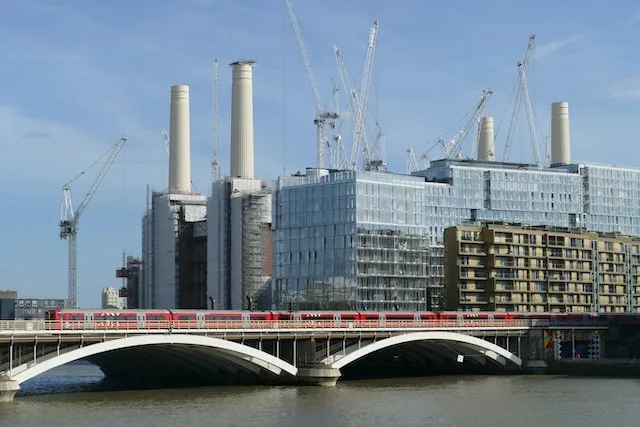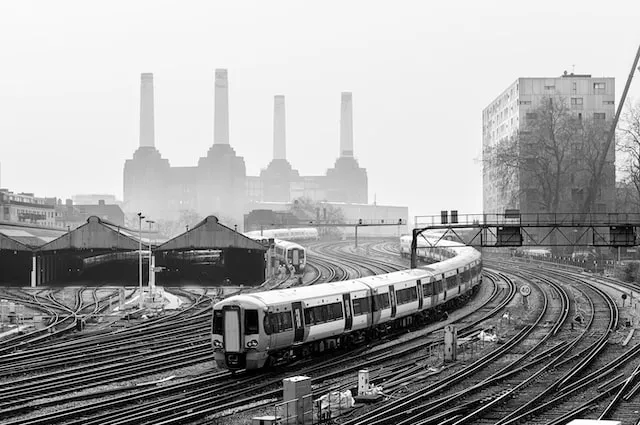The Battersea Power Station in London is an iconic building directly at the Thames river that has shaped the city’s skyline for decades. While being built in 1929, the structure has been decommissioned in 1975 and has remained empty for almost 50 years. Now, in 2022 the newly redeveloped Battersea Power Station has opened up again but with a completely new purpose and use. In the following article, you will find out how the building and its environment have changed, as well as understand the challenges during its planning and construction phase.

The History and Early Development Proposals
In the early 1930s, when the power station opened, it generated electricity by using coal that was delivered by boats thanks to its ideal location at the Thames. The building could be seen from miles away throughout the city due to its four distinct chimneys that stick out of its corners. Another feature that the architect Giles Gilbert Scott used to create the iconic design was the use of red bricks which made the massive structure stand out even more. Many elements of the Battersea Power Station have been inspired by the Art Deco style which had its peak in popularity during the 1920s and 1930s.
After operating for many decades the building became outdated and could not produce the desired output anymore. Therefore the city decided to close the station in 1975. Many citizens of London wanted to keep the Power Station and were able to convince the local authorities to grant it a Grade II listed status. This UK certification means that it is of national importance and therefore every effort must be made to preserve the building. As one can imagine, this status comes with a significant amount of planning restrictions that will impact a potential redevelopment in the future.
Nevertheless, many real estate companies and developers tried their luck with the Battersea Power Station and proposed plans to revitalise the historic building. Starting as early as 1983, some ideas included an indoor theme park, offices, residential housing, a hotel, a stadium, and more. Most of the plans have not made it to the actual construction stage as they were either too risky, too expensive or changed the building to such an extent that the Grade II status would have been affected.

Redevelopment of the Battersea Power Station
Finally, in 2012 the property was listed for sale again and bought by the Malaysian investors SP Setia and Sime Darby Property for £400 million. While this price might seem high, the total costs for the redevelopment would amount to about £9 billion additionally. The plan not only included a major refurbishment and development of the existing power station but also the creation of housing, offices, retail, hotels, and public spaces in the surrounding area, creating an entire neighbourhood south of the Thames.
In total, an area of 42 acres was going to change drastically and be one of London’s largest real estate projects in recent years. The redevelopment has been conducted in four stages.
1 | Circus West Village
In the first phase, the Circus West Village has been constructed which provides 865 apartments, retail spaces, offices, a theatre, a cinema, and access to the docks with a new river shuttle. This part has been designed by the architects SimpsonHaugh and Partners, as well as De Rijke Marsh Morgan.
2 | Battersea Power Station
The second phase included the iconic Battersea Power Station itself which was likely to attract a large number of visitors. Therefore it included a viewing platform on top of one of its chimneys, as well as opportunities to discover the historic building. More than 100 shops, restaurants, bars and cafes can be found within the station, but also an event venue, food hall and 254 apartments. WilkinsonEyre is the architect for this part of the redevelopment project. A reason why the investors have chosen this company is that they already have experience with another historical renovation of a Giles Gilbert Scott building.
3 | Electric Boulevard, Battersea Roof Gardens & Prospect Place
In section three a number of areas will be constructed, including the Electric Boulevard, Battersea Roof Gardens & Prospect Place. Here, more than 1,300 homes will be created in addition to new restaurants and retail spaces. An important part of this phase is the opening of a new metro station that will still be in London’s zone 1 tube network. It will allow residents and visitors to travel between central London and Battersea more easily and faster. Part three of the development project is designed by the famous architects Foster + Partners and Gehry Partners.
4 | Affordable Housing & Medical Centre
Lastly, the proposed redevelopment plan must also include affordable homes that will be situated to the southeast of the main part. The increase in newly developed housing, offices, and new amenities have driven up rental prices in the area. Different sources criticize that not enough has been done to support existing residents and that the plan leads to an increase in gentrification within the Battersea area. Other facilities in the fourth section include a medical centre, business incubator and public spaces.
All of the architectural design has been aligned with the historic building to keep its aesthetic and iconic status in London. To meet sustainability standards, the redevelopment has its own new power plant, which is located 10 meters below the public park. Its goal is to create electricity and heat for the entire project, as well as the surrounding area. Furthermore, some of the roofs have been fitted with green roof– and rainwater harvesting systems to reduce water consumption.
In the end, the final redevelopment of the Battersea Power Station in London was opened in October 2022 and allowed people to access a variety of high-quality shops, restaurants, bars and cafes. But not only residents came to visit the new attraction, many tourists took a tube ride to the iconic landmark as well. According to the TFL, the number of people taking the tube to the site has risen by 5 times the usual number with the opening of the new tube station.
Conclusion
The Battersea Power Station is an iconic building that has shaped London’s skyline for many decades. After it got shut down due to performance issues, many developers and investors proposed plans to revitalize the property. Only in 2012, a final redevelopment plan has been accepted and started its construction. Now, an entirely new neighbourhood exists in the southwest of central London with many new apartments, high-quality shops, offices, cultural amenities, and public spaces. The first few weeks after opening have shown promising results but only time can tell if the redevelopment will provide the benefits its investors have presented.
If you want to learn more about the future of commercial real estate, including topics such as sustainability & ESG, PropTech, architecture, development and investment, feel free to take a look at our other articles on Smart CRE. Here you will also find insights into the job market and how to start a career in real estate.
To stay up-to-date, we would be very happy if you subscribe to our monthly newsletter. Just enter your e-mail address below. Thank you!

